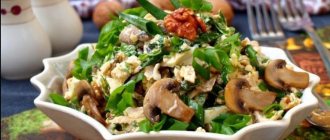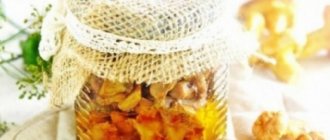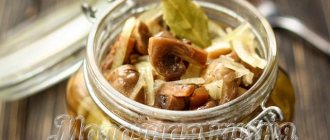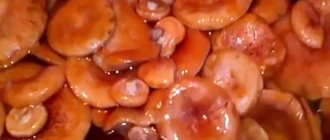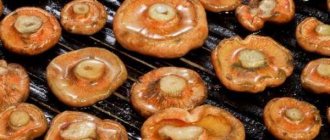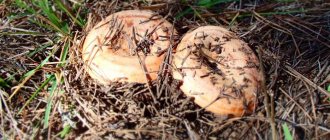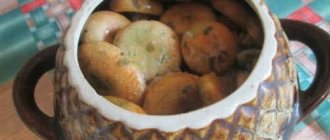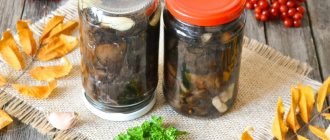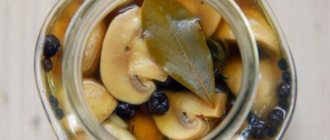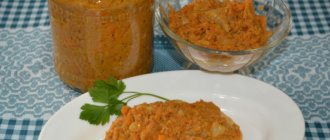Today we decided to introduce readers to how you can pickle saffron milk caps in jars for the winter. Simple recipes are based on the basic principles of preservation and involve various methods and technologies of preparation. It is not for nothing that saffron milk caps have long been considered one of the most attractive mushrooms. They are not included in the category of “noble”, but belong to the highest category of nutritional value, are well absorbed by the human body and have an interesting, piquant taste, extremely valued by connoisseurs.
Pickled saffron milk caps (pictured) are an excellent appetizer that can be served as a separate dish or as a side dish, or added to pies and salads.
Pickled saffron mushrooms are served as a cold appetizer, used as an independent lunch dish (for example, with a side dish of hot boiled potatoes), and also added to winter salads and pie fillings. We bring to your attention some of the most interesting step-by-step methods on how to pickle saffron milk caps at home in a tasty and quick way.
Salting is another way of processing food. Read about cold salting of saffron milk caps and other recipes on our website.
Nuances of processing and preparation
When starting to prepare pickled saffron milk caps, you should pay attention to several nuances:
- Saffron milk caps are one of the cleanest mushrooms. They do not require thorough rinsing. It is enough to clean the mushroom from sand and debris adhering to the cap.
- If the mushrooms still need to be washed, they are soaked for half an hour in cold water, after which they are thoroughly washed under running water.
- Before pickling, mushrooms need to be boiled in salted water, since, like honey mushrooms, saffron milk caps secrete mucus. Cooking before canning and pickling significantly reduces their stickiness.
- After blanching, saffron milk caps can be canned, salted and pickled.
Useful properties and types of saffron milk caps
Saffron milk caps: 1-Pine 2-Red
A distinctive feature of saffron milk caps is their bright orange color. This color is due to the increased content of beta-carotene in the pulp, which is a source of retinol. In terms of the content of vitamin C, riboflavin, niacin and other useful substances, these mushrooms are equal to vegetables and fruits. Camelinas contain a lot of fiber, saccharides, ash elements, phosphorus, potassium and calcium. Eating them has a beneficial effect on the health of skin, hair, and nails.
Camels are natural antibiotics that inhibit the growth of many pathogenic microorganisms. This feature has led to the use of these mushrooms in traditional medicine recipes.
In nature, there are several types of saffron milk caps, differing in their places of growth, color and maximum size:
- Pine (ordinary) - grows in mixed forests and pine forests. This species is the most common in our country and is distinguished by the brightest color. Pine camelina is reddish-red, stocky, with a round cap up to 18 cm in diameter. The height of the stem is up to 10 cm.
- Spruce - grows only near spruce trees, since it forms mycorrhiza with their roots. The mushroom cap is light orange, covered with darker spots and rings. As it grows, the shade of spruce saffron becomes dark green. When salted, this species is fragrant and tasty, but turns greenish-brown.
- Red - common in coniferous forests. It differs from other species in its reddish-pink or deep orange hue. Hat with a diameter of up to 10 cm, without adhesive coating. The flesh is pinkish, with burgundy spots.
- Milky red - most often found near pine trees, but sometimes in mixed forests. The cap of this species is up to 9 cm in diameter, light orange, with a pinkish edge. Over time, a greenish tint appears on the surface.
- Japanese - the color of the cap is pale pink or light orange with an ocher-salmon or terracotta center. The diameter of the cap is 6 – 8 cm. The height of the stem is up to 7 cm. The flesh of this species, unlike the others, does not turn green where it is cut or broken.
- Blue - found in Karelia and the Arkhangelsk region. A distinctive feature of the species is its bright blue color at the cut points. The cap is pale yellow, the plates are bright orange.
- Oak – brick-orange or yellow-orange. The underside of the cap is covered with frequent, wide plates of orange or pale pink color. The flesh of the mushroom is white or creamy and does not change color when exposed to air. The content of milky juice in this variety is high, so oak camelina requires soaking before cooking.
Expert opinion
Melnikov Vladimir Mikhailovich
Knows 1000 ways to cook, pickle and marinate any types of mushrooms
All types are edible and can be used for pickling.
Marinated saffron milk caps with apple cider vinegar and spices
Difficulty of preparation:
Easy
Cooking time:
40 minutes
Step 1
Using a pastry brush, thoroughly clean and remove all dirt from freshly picked mushrooms.
Step 2
Prepare a jar for pickling by first sterilizing it with boiling water.
Step 3
Add apple cider vinegar, water, salt, sugar, saffron, turmeric and garlic to a saucepan and bring to a boil.
Step 4
Boil for 5 minutes until the liquid becomes fragrant and golden.
Step 5
Add peeled mushrooms and cook in vinegar over low heat for 8-10 minutes until soft.
Step 6
Transfer the mushrooms to an airtight glass container.
Step 7
Drizzle the vinegar mixture over the top, making sure all the mushrooms are completely covered.
Step 8
Carefully turn the marinating container upside down (this helps create a vacuum inside the glass, which will extend shelf life), place in a dark, dry place in the kitchen and allow to cool to room temperature.
Finish
Place in a cool place.
Mushrooms according to this recipe will be stored for up to 12 months.
Ingredients for 500 g of saffron milk caps
| Water | 1 l |
| Apple vinegar | 1 l |
| Salt | 2 tsp. |
| Sugar or honey | 3 tbsp. l. |
| Saffron | 1 pinch |
| Turmeric | 1/4 tsp. |
| Garlic | 1 clove |
Hot poured
You can marinate saffron milk caps for the winter in jars using a hot method in a specially prepared filling. This is the most popular cooking method. Mushrooms can taste different: more or less sour, depending on the amount of vinegar poured.
Products used:
- saffron milk caps after preliminary boiling – 1 kg;
- water – 1 l;
- salt – 1.5 tbsp. l.;
- sugar – 2 tbsp. l.;
- vinegar essence (70%) – 1–2 tsp;
- peppercorns of different types - 8–12 pcs.;
- cloves – 6–8 pcs.;
- bay leaf – 2–3 pcs.;
- garlic – 2–3 cloves per 1 jar;
- spices and horseradish root to taste.
Step by step description:
- Spicy seasonings and garlic are placed directly into sterilized jars to taste; you can add part of a hot pepper pod.
- Everything is mixed with pre-boiled saffron milk caps. Proper styling should be free without pressure.
- Then water is poured in, mixed with seasonings and boiled for 3-4 minutes.
- Vinegar is added last.
Jars with fruits are filled with boiling mixture to the top and pasteurized: half-liter jars - 10 minutes, liter jars - 15 minutes.
Roll up the jars and turn them over until they cool completely. You can even store pickled saffron milk caps in a room, at normal temperature, for about a year.
Italian marinated saffron milk caps
Cooking difficulty:
Medium
Cooking time:
60 minutes
Step 1
To improve the taste, you can use a mixture of refined olive oil and cold-pressed oil.
Clean the saffron milk caps from dirt and sand.
Step 2
In a narrow, high-sided saucepan, bring vinegar, salt and water to a boil.
Step 3
Boil a portion of whole saffron milk caps (100 g) for several (up to 10) minutes, until they become soft when pierced with a skewer.
Step 4
Remove to a wire rack with a slotted spoon and continue to cook the mushrooms in batches until all are cooked.
Step 5
Carefully remove excess liquid with a kitchen towel and cut the saffron milk caps into thin slices.
Step 6
Taste the mushrooms for salt, adding additional salt if necessary.
Step 7
Place in a sterilized jar with garlic pieces, rosemary and basil.
Step 8
Pour in enough oil to cover.
Finish
It is important not to overcook the saffron milk caps in the broth, as they quickly absorb water and may become too wet.
Mushrooms can be stored in the refrigerator for 3-4 weeks.
Ingredients for 300 g of saffron milk caps
| Water | 3 glasses |
| White wine vinegar | 1 glass |
| Olive oil | 2 glasses |
| Rosemary | 1 sprig |
| Basil | 5 leaves |
| Garlic | 2 cloves |
| Salt | 3 tbsp. l. |
Preparation of raw materials
It is recommended to begin processing any mushrooms no later than 3-4 hours after collection. If stored for a longer period of time, harmful substances may accumulate in them. In addition, saffron milk caps also lose their attractive appearance, as over time greenish-marsh spots appear on them in places where they are cut, damaged, or even pressed with fingers.
Saffron milk mushrooms quickly develop “bruises” in places of cuts, damage and even pressure, so you need to start processing mushrooms as soon as possible
The collected mushrooms are cleaned of soil and forest debris and thoroughly washed in running water . After this, choose a pan that is large enough to hold an equal amount of water in addition to the saffron milk caps. Boil primary brine , adding 1-1.5 tablespoons of rock salt for every liter of water. When the solution boils, lower the mushrooms into it and cook, periodically removing the foam, until they begin to settle to the bottom. For saffron milk caps, this time is usually about 15 minutes (when properly boiled, they retain a fairly bright color and the ability to crunch appetizingly). Then the mushrooms are placed in a colander and quickly washed with cool water, and the brine is poured out .
It is preferable to pickle saffron milk caps whole , since their fruiting bodies are fragile and, when cut, can crumble, making the liquid in jars cloudy and unsightly. For seaming, experienced housewives choose small mushrooms - with caps up to 5 cm in diameter. The stems are usually separated from the caps .
An old recipe for pickled saffron milk caps with sherry
Difficulty of preparation:
Easy
Cooking time:
30 minutes
Step 1
If necessary, you can replace the sherry with the same amount of red wine vinegar.
Peel the saffron milk caps. To do this, soak and rinse them in a vinegar solution (6 cups of water with 1/2 cup of white vinegar).
Step 2
Add sherry or wine vinegar, water, sugar, olive oil, peppercorns, garlic, juniper berries, bay leaves, rosemary and thyme to a saucepan and bring to a boil.
Step 3
Add pre-chopped mushrooms and simmer for 1 minute.
Step 4
Remove from heat and cool to room temperature.
Finish
Once cooled, place in a sterilized jar. Make sure the liquid completely covers the mushrooms.
You can store saffron milk caps in the refrigerator for 6 months (the liquid should cover the saffron milk caps).
Ingredients for 250 g of saffron milk caps
| Sherry | 200 ml |
| Water | 200 ml |
| Sugar | 100 g |
| Olive oil | 50 ml |
| Garlic | 3 cloves |
| Black pepper | 5 peas |
| Bay leaf | 2 pcs |
| Rosemary | 1 sprig |
| Thyme | 1 sprig |
| Juniper | 5 berries |
Other recipes
Ryzhiki can be preserved in their own juice, this is a quick way. At the same time, the marinade turns out to be spicy, which is not to everyone’s taste. Mushrooms are washed and boiled in small portions in 1 liter of water. The fruits will boil down and, after light compaction, will be covered with boiling water.
Then they add the usual set of seasonings and vinegar to taste. Place in sterilized jars and store for long-term storage.
Marinating saffron milk caps is also possible in the traditional way, but citric acid is added to the water during the first boiling. Then close as usual. This changes the taste of the final product.
Marinade with horseradish for hot-cooked saffron milk caps for the winter
We offer a recipe for a marinade for saffron milk caps prepared for the winter by hot pickling. The resulting snack is very tasty, aromatic and crispy.
- Saffron milk caps – 3 kg;
- Salt – 3 tbsp. l.;
- Cloves – 5 pcs.;
- Bay leaf – 3 pcs.;
- Water – 1.5 l;
- Horseradish leaves.
- After pretreatment, mushrooms are boiled for 5 minutes in boiling water.
- Place in sterilized glass jars with clean horseradish leaves on the bottom.
- Start preparing the marinade: combine salt, bay leaf and cloves in the water from the recipe.
- Boil for 5-7 minutes over low heat and strain.
- Hot marinade for saffron milk caps is poured into boiled mushrooms and covered with nylon lids.
- After complete cooling, take it to a dark and cool basement. After 10-15 days, the mushrooms can be washed, seasoned with oil, onions cut into half rings and served.
Clean and soak mushrooms
Before boiling, salting or canning a healthy mushroom treat for the winter, you should first prepare the main ingredients. To do this, you will need a small, sharp cutter and a kitchen sponge.
Preparing mushrooms is as follows:
- Sort out freshly cut mushrooms.
From the moment of harvesting to subsequent processing, no more than 10 hours should pass, provided that the ingredient is stored in a cool room. Fresh mushrooms do not tolerate long-term storage.
- Using a knife, cut 3-4 millimeters from the end of the “leg” of the mushrooms. Cut out damaged, damaged areas.
- Using a washcloth or kitchen sponge soaked in water, wipe the mushroom caps from debris and dust.
- Pour the preparations into a basin and fill with salted water. To maintain a bright shade, add 2-3 teaspoons of lemon to the container.
- Leave the raw materials to soak for 20-30 minutes.
- Place the mushrooms in a colander and rinse with running water.
- Spread the harvest on a waffle towel and dry.
At the same time, prepare jars sterilized by steam, in an oven or microwave, and lids boiled in boiling water.
Advice from experienced housewives
You may be interested in: How to pickle saffron milk caps: recipes for delicious mushrooms Marinated Chinese and white cabbage in Korean Royal, apricot jam with seeds
As with any dish, preparing mushroom reserves for the winter has its secrets. You can learn them from personal experience or ask advice from a good housewife. This section contains the most useful and effective tips:
- You should cover the saffron milk caps entirely, separating only the stem from the cap, as they break easily and can make the marinade cloudy.
- It is more convenient to use nylon lids, which fit more tightly to the jar.
- Any twists must be stored in a dark place out of direct sunlight.
- Regular vinegar can be replaced with vinegar essence, ascorbic or citric acid.
- The marinade should make up at least a fifth of the contents of each jar.
- The liquid must completely cover the mushrooms, otherwise they will spoil.
When picking mushrooms yourself, you should be careful and confident in your knowledge. One poisonous mushroom in a jar can lead to very bad consequences. It is better to check all the mushrooms with a knowledgeable person or purchase them from reliable people.
How to properly pickle store-bought or forest saffron milk caps
There are three ways to pickle mushrooms: hot, cold and without sterilization. They differ in the sequence of actions, the duration of the process, labor intensity and result.
Hot method
This item is suitable for connoisseurs of juicy mushrooms with a delicate taste and structure. The hot marinating method involves cooking all the ingredients together. It is necessary to place the main product, spices, additives, water in a large saucepan and cook the entire contents for about half an hour.
During this time, sterilize glass jars to avoid mold. Pack the prepared mass into containers and cover with a lid. The resulting liquid inside the jars will taste especially aromatic.
How to cold pickle saffron milk caps in jars
This recipe is very simple, there are no clear proportions, and the only ingredients you need are saffron milk caps and salt. Due to the absence of heat treatment and spices, the mushrooms are completely preserved in this method.
How to cook:
- Place clean saffron milk caps on the bottom of the pan. Sprinkle one or two teaspoons of salt on top, then add another layer and salt again. Lay out all the mushrooms, sprinkling each layer with salt.
- Press the mushrooms on top with a plate and press. Place the pan in a cool place for several days.
- When the saffron milk caps are salted, put them in jars and roll them up.
As you can see, everything couldn’t be simpler! By the way, if the mushrooms are quite clean, without sand and soil, they don’t even need to be washed.
